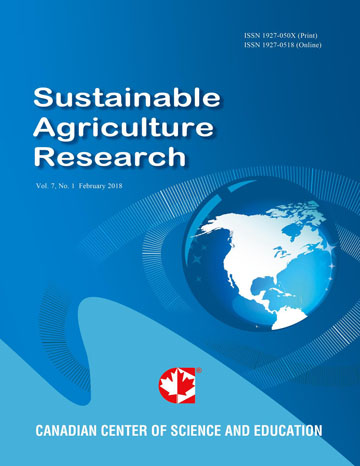Influence of Phosphorus Fertilizer on “Ware” Potato Production in Acid Soils in Kenya
- Evans Mutange Akoto
- Caleb O. Othieno
- Julius O. Ochuodho
Abstract
One of the major challenges facing potato (Solanum Tuberosum L) production in Kenya is low and declining yield. This trend is caused by several factors which include low quality and quantity of seed, climate change, inadequate extension services, pests and diseases and more importantly low and declining soil fertility, particularly phosphorus (KEPHIS, 2016 and Karanja et al., 2014). Unfortunately, the current phosphorus fertilizer rate recommendation available for “ware” potato production in Kenya is “blanket” or general (90 kg phosphorus ha-1) and has not been updated for a long time to address the declining soil fertility. This prevents proper utilization of phosphorus fertilizers in achieving optimal production of “ware” potatoes. Therefore, this study investigated influence of different rates of phosphorus (TSP) fertilizer on “ware” potato yield and quality in three acidic (pH ≤ 5.8) test sites: Lari, Ainabkoi and Saboti sub Counties. Two varieties, Unica and Shangi, were tested. The field experiment was a split plot arrangement in Randomised Complete Block Design (RCBD) with six treatments (0 N & 0 P), 0, 30, 60, 90 and 120 kg ha-1 phosphorus, replicated three times. Data collected included weight, quantity and quality of tubers. The data was analysed using analysis of variance (ANOVA) at 5 % confidence levels with General Statistics (GENSTAT) and excel soft wares. Results indicated that phosphorus fertilizer influenced “ware” potato yield. At Saboti application of 120 and 90 kg phosphorus ha-1 for Shangi and Unica resulted in highest “ware” yield of 19.6 and 40.2 t ha-1, respectively. At Ainabkoi application of 120 kg ha-1 phosphorus produced highest “ware” potato yields of 10.7 t ha-1 and 26.8 t ha-1 of Shangi and Unica, respectively. At Lari, application of 90 and 120 kg ha-1 phosphorus produced highest “ware” potato yield of 7.0 t ha-1 and 17.5 t ha-1 for Shangi and Unica, respectively. During the season, there was a build-up of soil available phosphorus. Thus, there is need for farmers to test their soil at the beginning of every potato growing season.
- Full Text:
 PDF
PDF
- DOI:10.5539/sar.v9n2p118
Index
Contact
- Joan LeeEditorial Assistant
- sar@ccsenet.org
